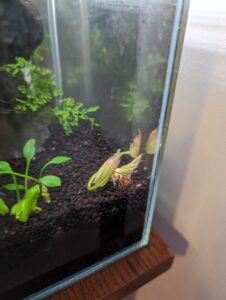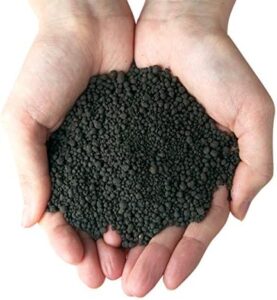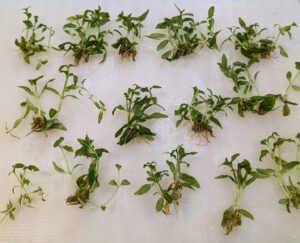Staurogyne repens is an ‘easy to grow’ and popular aquatic plant. I have been resisting trying this plant for some reason… too easy, too popular? Anyway, it has a low growth habit but isn’t a carpeting plant, so seems like it might be right for the Shrimphaus. I usually prefer potted plants, but at the time could only find S. repens as an in vitro pot, so picked one up from Aquarium Gardens, as grown by Tropica.
Month: September 2024

Replanting actually… I was looking for something that could grow submersed in the back right corner of the Shrimphaus that might be able to break the water surface and grow emersed. Amazon sword plants (Echinodorus species) are sometimes able to do that and I looked for an intermediate sized one with interesting aspects and came up with Echinodorus chrileni. I first picked up a pot from Pro-shrimp grown in rockwool by Aquafleur about 8 months ago. The plant arrived in great shape, but then gradually rotted away over several months, with no evidence of transitioning to the submersed growth form. This was back when I was using the Asta point-source lighting that was at the exact opposite corner of the tank so the spot for the chrileni was pretty shaded. When I switched over the Shrimphaus to the more even lighting from a Week Aqua S-400 Pro light, I figured let’s give the chrileni another try.

Aquasoil (there are various brands and types) is “an active bottom layer that lowers the pH value and slightly affects the water chemistry“. One aspect is to slowly leach out fertiliser into the water column over time. How about that ‘lowers the pH’ piece? One way would be to have the aquasoil directly add acid to the water but that wouldn’t last very long. Instead it is thought (although not published – trade secret) the aquasoil has an element of being an ion exchange matrix. This means there are charged surfaces on the aquasoil that can be pre-loaded with either positively charged (cations) or negatively charged (anions) molecules. These ions are slowly ‘exchangeable’ with ions of similar charge from the water column. For pH lowering purposes, the aquasoil would need to come pre-charged with H+ ions, possibly in the form of ammonium (NH4+), which can be exchanged for calcium (Ca++) or magnesium (Mg++) from the water column. The net effect would be to soften the water (removing Ca++/Mg++), add nitrogen based fertiliser (the ammonium) and to lower the pH of the water. All three of these effects are thought to be beneficial in a planted aquarium.
Recently following a heavy rain one of the residual current breakers (RCD) on the main breaker box of the house tripped and could not be reset which took down half of the lighting and almost all of the wall sockets. I strung up a network of extension leads to the one remaining live socket (for the cooker) to keep power to the fridge/freezer and the boiler. What about the critters? I strung another lead through to power on the Shrimphaus to keep the new caridina shrimp happy with water flow, oxygenation and light. So far so good – call the electrician. Meanwhile, lets get the internet back on (check) and probably good to sort the Fireplace Aquarium as well. Connecting the powerbar for the Fireplace Aquarium immediately trips the RCD on the cooker socket circuit, taking down most of the rest of the power to the house.

